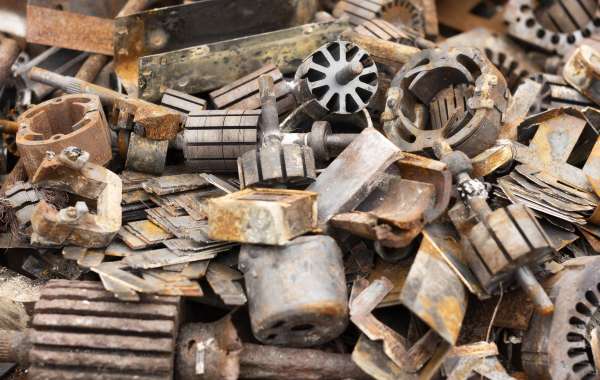Metal recycling is one of the most important practices in the world of waste management and sustainability. As the global demand for metals continues to rise, recycling these valuable materials has become essential for conserving resources, reducing energy consumption, and minimizing environmental impacts. From aluminum cans to industrial scrap, metal recycling plays a crucial role in helping to create a circular economy. In this blog, we’ll dive into what metal recycling is, how it works, the benefits it offers, and why it is crucial for both the environment and the economy.
What is Metal Recycling?
Metal recycling is the process of recovering scrap metal from various sources, such as old appliances, vehicles, construction materials, and industrial waste, and converting it into reusable metal. The recycled metal is then melted down, purified, and reshaped into new products for manufacturing. This reduces the need to mine raw materials, conserves energy, and reduces the environmental damage caused by extracting metals from the earth.
There are two main types of metals that can be recycled:
Ferrous Metals: These metals contain iron and are magnetic. Common examples include steel and cast iron. Ferrous metals are widely used in construction, automotive manufacturing, and appliances.
Non-Ferrous Metals: These metals do not contain iron and are non-magnetic. Examples of non-ferrous metals include aluminum, copper, brass, and zinc. These metals are used in electrical wiring, pipes, electronics, and various other industries.
Both ferrous and non-ferrous metals are valuable in recycling, though non-ferrous metals tend to be more expensive and often provide greater profit for recyclers due to their scarcity and higher demand.
The Process of Metal Recycling
Metal recycling is a multi-step process that involves collection, sorting, processing, and repurposing metal. Here's how the process works:
Collection and Sorting:
The first step in metal recycling is the collection of scrap metal. Scrap can be sourced from various places such as households, businesses, construction sites, and demolition projects. Once collected, the metal is sorted into ferrous and non-ferrous categories. This sorting is often done using magnets, as ferrous metals are magnetic, while non-ferrous metals are not.Shredding and Cleaning:
After sorting, the metal is cleaned to remove any contaminants such as paint, plastic, or oil. The metal is then shredded into smaller pieces, making it easier to process and melt down. This step helps ensure that the recycled metal is of high quality.Melting:
The shredded metal is then melted in a furnace at high temperatures. This process requires a substantial amount of energy but is far more efficient than mining and processing new metals from raw ores. During the melting process, impurities are also removed, ensuring the metal is clean and ready for reuse.Refining and Casting:
After melting, the metal is refined and purified to remove any remaining impurities. Once purified, the molten metal is cast into new shapes, such as ingots or billets, which can then be used by manufacturers to create new products.Manufacturing New Products:
Finally, the recycled metal is sold to manufacturers, where it is used to produce a wide variety of goods, from new cars and appliances to electronics and building materials. By using recycled metal, manufacturers can reduce their reliance on raw materials and minimize their environmental footprint.
The Environmental Benefits of Metal Recycling
Metal recycling offers numerous environmental advantages, making it an essential part of sustainable practices. Here are some key environmental benefits:
1. Reduces Energy Consumption:
Recycling metals saves a significant amount of energy compared to producing new metals from raw materials. For instance, recycling aluminum saves up to 95% of the energy required to extract aluminum from bauxite ore. Recycling steel saves about 60% of the energy needed to produce new steel from iron ore.
2. Lowers Greenhouse Gas Emissions:
Because recycling metal uses less energy, it also results in fewer greenhouse gas emissions. This reduction in emissions helps fight climate change by lowering the carbon footprint associated with metal production.
3. Conserves Natural Resources:
Mining for metals requires the extraction of raw ores, which can have severe environmental consequences, such as habitat destruction, water pollution, and high carbon emissions. By recycling metal, we reduce the need for new mining activities, helping to preserve ecosystems and conserve natural resources.
4. Reduces Waste and Landfill Usage:
Recycling metal helps reduce the amount of waste that ends up in landfills. Metals can take centuries to break down in landfills, so recycling these materials ensures that they don't contribute to long-term waste buildup.
The Economic Benefits of Metal Recycling
In addition to its environmental benefits, metal recycling also offers significant economic advantages. Here’s how:
1. Job Creation:
The metal recycling industry supports thousands of jobs across various sectors, including collection, sorting, processing, and manufacturing. According to the Bureau of Labor Statistics, the recycling industry in the U.S. generates more than 500,000 jobs. By investing in recycling programs, communities and businesses contribute to local employment and the economy.
2. Cost Savings for Manufacturers:
Using recycled metal instead of raw materials is often cheaper for manufacturers. Recycled metal is typically more affordable than new metal, which helps lower production costs and increase profits. Additionally, by using recycled materials, manufacturers can improve their sustainability credentials and appeal to environmentally conscious consumers.
3. Decreases the Need for New Mining:
As metal recycling helps reduce the demand for raw materials, it lowers the costs and environmental impact associated with mining and extracting new ores. This is not only beneficial for the planet but also helps stabilize global metal prices by providing a steady, secondary source of metal.
4. Economic Growth for Local Communities:
Scrap metal recycling contributes to local economies by reducing waste and providing raw materials for manufacturing. Recycling also helps reduce landfill costs, creating savings that can be invested in other areas of local development, such as infrastructure and education.
Common Metals That Are Recycled
Here are some of the most commonly recycled metals and their uses:
Aluminum:
Used in beverage cans, foil, automotive parts, and aerospace components, aluminum is one of the most commonly recycled metals due to its energy-efficient recycling process.Steel:
Steel is widely used in construction, appliances, and automotive industries. Recycling steel reduces the need for mining and conserves valuable resources.Copper:
Copper is essential for electrical wiring, plumbing, and electronics. Copper recycling reduces the demand for newly mined copper and is an integral part of sustainable manufacturing practices.Brass and Zinc:
Brass and zinc are often used in industrial applications, plumbing fixtures, and musical instruments. Both metals are highly recyclable and are commonly found in scrap metal.
How to Get Involved in Metal Recycling
Getting involved in metal recycling is simple and effective. Here’s how you can participate:
Recycle at Home:
Look around your home for old appliances, electronics, or scrap metal that can be recycled. Items like aluminum cans, copper wiring, and old steel appliances are common household recyclables. Many local recycling centers will accept these materials.Recycling for Businesses:
Businesses that generate significant amounts of scrap metal, such as construction companies, manufacturers, and auto repair shops, can set up recycling programs to manage their waste and contribute to a circular economy.Support Recycling Programs:
Encourage your community to invest in recycling programs. Whether through local initiatives, educational campaigns, or government policies, supporting recycling efforts helps build a culture of sustainability.
Conclusion
Metal recycling is a powerful solution for reducing environmental impact, conserving resources, and fostering economic growth. By recycling metals, we save energy, lower greenhouse gas emissions, reduce the need for mining, and create jobs within the recycling industry. As metal consumption continues to rise, it’s more important than ever to prioritize recycling as a means to create a sustainable and circular economy.
Whether you’re an individual looking to recycle your old aluminum cans or a business aiming to streamline your waste management process, metal recycling provides a tangible way to contribute to a greener, more sustainable future. Let’s work together to ensure that the metals we use today can be reused tomorrow!




